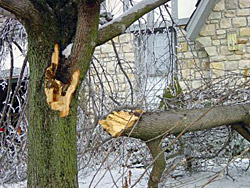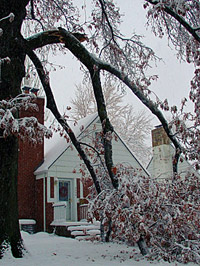|
Get Our Free Newsletter
Home
Previous
Issues
Advertise
Donations
Site
Search
Contact Us
Feature
Articles
Privacy
Pledge
|
 The
fate of individual trees during an ice storm depends on a number of
factors: The
fate of individual trees during an ice storm depends on a number of
factors:
Tree Size
The bigger the tree, the less likely it will be killed. All other
things being equal, small trees are more likely to bend; big trees are
more likely to break.
Crown
Size
Crowns are the center of ice deposition. Trees with bigger crowns are more
likely to have branch
 loss,
which can affect the rate of recovery during subsequent growing seasons. loss,
which can affect the rate of recovery during subsequent growing seasons.
Basal Area
Trees from stands with high basal area are more likely to be damaged than
trees from stands with low basal area.
Recent
Thinning
Trees from stands that have been recently thinned are more likely to be
damaged than trees in stands not recently thinned.
Recovery of individual trees depends on the nature and the
severity of damage. The following suggestions are gleaned from
the literature, and from preliminary looks at the new studies
that have recently been installed.
-
Bent Trees
-
If the bend is 30% from vertical or less, the tree will
probably survive.
-
If the bend is a long gradual bend rather than a sharp bend,
the tree has a higher chance of straightening up. The sharp
bend may indicate some physical structural damage to the
bole.
-
If your tree has a name (e.g., a highly desirable yard tree
or a favorite tree owned by a weekend tree farmer) you can
try to use a rope to straighten up a tree. But you’ll need to
leave the rope in place for a year or two, until the tree lay
down some additional years of growth (cones of wood).
-
Bent trees are extremely dangerous to cut! The tree will
release built-up stress 180°
AWAY from the bend - right where you’d be standing with a
chain saw if you were trying to cut the tree down. Only the
most experienced chain saw users have the skill and training
needed to cut down a badly bent tree. This is NOT for the
weekend tree farmer to try.
-
Broken branches
-
Survival depends on the number of broken branches. A tree
with only a few broken branches will recover. A tree with
most of its branches broken is much less likely to recover.
-
Wood rotting fungi can invade through the wound, and there’s
not much one can do about that.
-
If your tree has a name, you can minimize the length of time
to heal the scars by pruning the branch stub flush with the
bole.
-
Broken top within a crown, or broken main stem
-
If the diameter outside bark (DOB) is 2 inches or less and
the tree still has lateral branches, the lateral will exert
dominance and take over as leader. The smaller the DOB at the
break, the less deformity the tree will have.
-
If the DOB is greater than 2 inches at the point of breakage,
the tree will probably show more significant deformity—either
a ‘bayonet’, where one branch eventually takes over as
dominant, or a U-shaped ‘lyre’, where 2 branches take over (a
double bayonet on opposite sides of the tree from the point
of breakage).
-
If the break occurs at a height lower than 18 feet, the tree
may never produce a decent sawlog. (1’ stump + 16’3” log +
some trim allowance)
-
If the stem breaks below the live crown, the tree is just
plain dead. No resprouting of branches will occur. The tree
will need a number of substantial branches to have a hope of
surviving.
-
Uprooted trees
-
A partially uprooted “root-sprung” tree is partially uprooted
forever. If that uprooting is very slight, the tree may try
to recover through additional root growth and deformed shoot
development—which will lead to a prominent sweep in the tree.
-
If your tree has a name, you might be tempted to winch the
tree back to vertical. That is not recommended! Even if the
tree survives, its structural uprightness is compromised. It
will permanently recover only if new load-bearing supporting
roots can grow over the years to replace the roots damaged
during the partial uprooting.
-
The partially uprooted tree may survive for a long time, if
most of its branches are still intact. But it will not
thrive.
Source
|
|

 The
fate of individual trees during an ice storm depends on a number of
factors
The
fate of individual trees during an ice storm depends on a number of
factors loss,
which can affect the rate of recovery during subsequent growing seasons.
loss,
which can affect the rate of recovery during subsequent growing seasons.